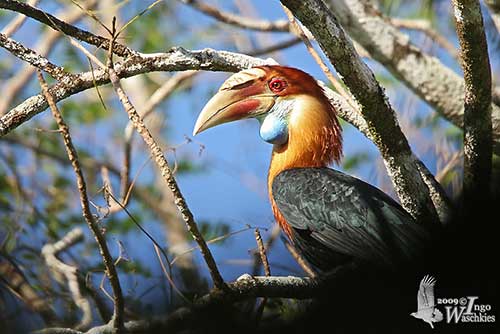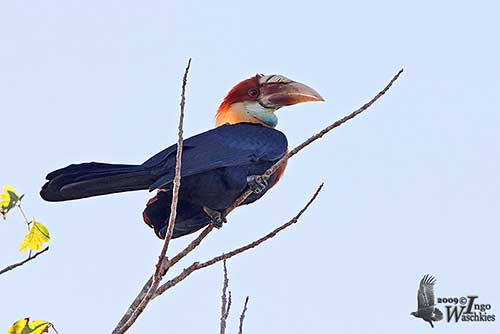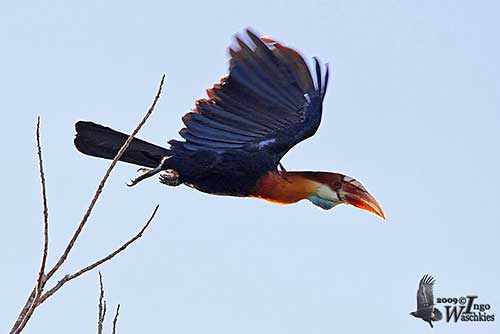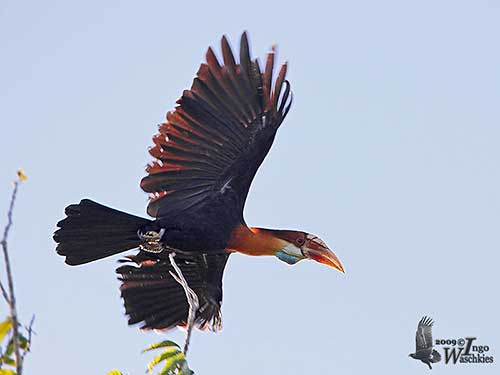
Fr : Calao de Sumba
Ang : Sumba Hornbill
All: Sumbahornvogel
Esp: Cálao de la Sumba
Ita: Bucero di Sumba
Nd: Soembajaarvogel
Sd: sumbanäshornsfågel
Photographer:
Ingo Waschkies
Bird Photography
Text by Nicole Bouglouan
Sources :
HANDBOOK OF THE BIRDS OF THE WORLD Vol 6 by Josep del Hoyo-Andrew Elliott-Jordi Sargatal - Lynx Edicions, 2001 - ISBN: 848733430X
The IUCN Red List of Threatened Species
THE AVIANWEB - Beauty of Birds (Sibylle Faye)
Wikipedia, the free encyclopaedia
Bird Ecology Study Group - Sumba Hornbill: Highly endangered
Sumba Hornbill
Rhyticeros everetti
Bucerotiformes Order – Bucerotidae Family
INTRODUCTION:
The Sumba Hornbill is an Asian species of genus Rhyticeros in the order Bucerotiformes. Mainly frugivorous, it may fly long distances to find suitable fruiting trees. It is gregarious and often forms large flocks at abundant food sources or at roosting sites, outside breeding season.
The Sumba Hornbill is found in W Lesser Sunda Islands. It has evolved independently on the oceanic island of Sumba. It has a low, wreathed casque and a long, all-black tail.
It is threatened by loss and fragmentation of the habitat, and 60% of forest has been lost since the 19th century. However, it is still present in protected areas, but the species is currently listed as Vulnerable.

DESCRIPTION OF THE BIRD:
Biometrics:
Length: 55 cm
The Sumba Hornbill male has black body plumage, both on upper and underparts. The long tail is all-black and there is a greenish gloss on the upperwing.
Head and neck are rufous, but crown and nape are darker. The bare skin of eyering and throat is blue, the latter with central dark patch.
The large bill is pale yellow with brownish-red parches near the base of both mandibles. The low, wreathed casque is yellowish with narrow brown bars. The eyes are red with pinkish eyelids. Legs and feet are dark grey.
The female (not displayed) has black plumage overall, including on head and neck. She is smaller than male.
The juvenile resembles adult male but the bill is small and the casque is absent.
RANGE:
The Sumba Hornbill is found on Sumba Island, W of Lesser Sunda Islands. It is an Indonesian endemic.
HABITAT:
The Sumba Hornbill frequents the semi-evergreen forests. It can be found in patches of deciduous forest, and extends into secondary forest and areas with fruiting trees. This species is usually seen in the lowland, and up to 950 metres of elevation.
CALLS AND SONGS:
The Sumba Hornbill utters just a few single notes in fast series “kokokokokok” like a loud cackling. It also gives a short “erm-err”.

BEHAVIOUR IN THE WILD:
The Sumba Hornbill is mainly frugivorous and feeds primarily on figs that have high-calcium level. It may occasionally take some animal food such as large insects and earthworms.
Thanks to their movements while searching for food, the hornbills are very important vectors of seed dispersal and play a role in the ecological balance of the tropical forest.
On the ground, it progresses by long hops with both feet together. It usually moves in pairs, but after the breeding season, they can be seen in small family groups.
They form large flocks at communal nighttime roosts where they are very noisy. They usually return to the same roost-site every evening in flocks of up to 70 individuals.
Some aggressive behaviour enhances the brightly-coloured head of the male that raises the bill to display the blue bare skin of the throat. When alarmed, it may make short, jerky movements of head and neck while perched with the body held low.
The Sumba Hornbill is monogamous and nests in natural cavities, often in trees. The pair visits several holes and selects the final nest-site which will be used in several following seasons.
Prior to nesting, the pair becomes territorial and defends a small area around the nest. During the courtship displays, the facial skin becomes brighter. The male frequently offers food to the female as courtship feeding, sometimes at nest entrance, even when she is outside. The nesting period usually occurs when fruits are abundant.
The Sumba Hornbill only performs local movements to find fruiting trees and to reach the roosting sites.
The flight is rather low with deep wingbeats, often interspersed with short glides.

REPRODUCTION OF THIS SPECIES:
From an observation of copulation in September, we can suggest that the laying occurs in October/November.
The Sumba Hornbill nests in natural cavity in tree, between 10 and 23 metres above the ground. It usually nests in large deciduous Tetrameles tree species, mainly where a branch has broken and fallen off. The nest entrance is about 12-40 centimetres wide.
Information about the nesting behaviour is currently lacking. The female is fed by the male at nest entrance during the incubation. The entrance hole is probably sealed during this period, as usual in hornbills.
The duration of the nesting period is unknown, but it varies according the size of the species. The chicks are altricial and naked at hatching. They have pink skin and closed eyes. The skin becomes blackish within the first week and the chicks open the eyes at 10 days old. When they are able to take the food brought by the male themselves, the female leaves the nest. She partially breaks the entrance to go out and the chicks reseal it with debris found inside the hole. Both parents feed them until they fledge.
PROTECTION / THREATS / STATUS:
The Sumba Hornbill is threatened by habitat loss through destruction and fragmentation of forest for agriculture and farming. Pet trade and exploitation for food have less important impact than habitat loss.
The population on Sumba Island is estimated at 1,650 mature individuals, to 6,400 individuals in the Manupeu-Tanadaru National Park (2010). But another estimate gives less than 4,000 individuals in total.
This population is declining, and the species is currently listed as Vulnerable.
